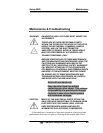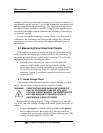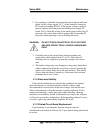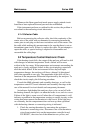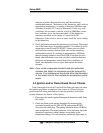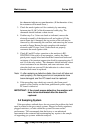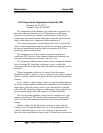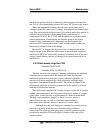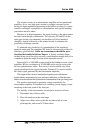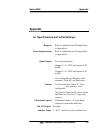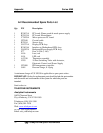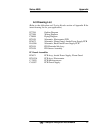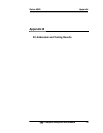
Series 4060 Maintenance
Teledyne Analytical Instruments 73
the thyristor gating circuit is continuously delivering gate current from
pin 4 of A1, thus maintaining constant full wave AC power to the heater.
When the temperature reaches the selected control point, pin 13
voltage is about the same as pin 9 voltage, and proportional control takes
over. The rate at which thyristor (triac) Q1 conducts and allows power to
be delivered to the heater is determined by the combination of
components R2 & R3, R4, C3, R5, and the thermistor resistance at the
control temperature. Consequently, the balance point of the bridge
formed by this combination of components can be altered by the
selection of R3, causing the circuit to seek a temperature at which the
thermistor resistance balances the bridge.
Because IC A1 triggers the thyristor at zero-voltage points in the
supply voltage cycle, transient load current surges and radio frequency
interference (RFI) are substantially reduced. In addition, use of the zero-
voltage-switch reduces the rate of change of on-state current (di/dt) in
the thyristor.
5.5.3 Electrometer-Amplifier PCB
Schematic No. B79159
Assembly Dwg. No. B79153A
The ions formed in the process of burning hydrogen in the presence
of hydrocarbon components of the sample gas cause an electrical
conduction between two electrodes in the combustion chamber (or
detector cell) that is amplified by a high sensitivity and high input
impedance electrometer-amplifier circuit. The electrical output of the
electrometer-amplifier is directly proportional to the quantity of flame
ionizable hydrocarbons present.
The electrometer amplifier PC board is located on the side of sample
module, interconnected to the electronics circuitry by means of a single
8 pins cable, so that the ease of replacement of a board is maintained.
The high input impedance requires a shield, or cover, which is
removable for access, as well as a shielded input conductor.
Interconnection with the collector is made by a coaxial cable.
Although the cable and fittings are intended for coaxial service,
the cable is actually being used as a shielded single-conductor
connection. The collector cable plugs into a coaxial connector on the
electrometer amplifier PC board, which is located at the side of the
sample module.




